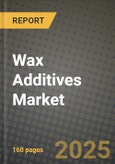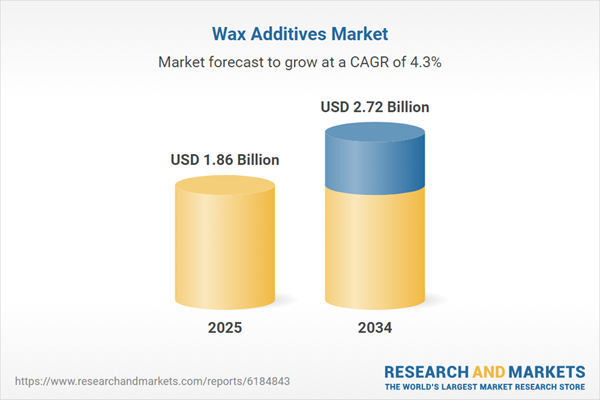Wax Additives Market
The Wax Additives Market spans synthetic and natural wax chemistries - polyethylene, polypropylene, Fischer-Tropsch, paraffin, microcrystalline, montan, carnauba, amide and tailored blends - delivered as micronized powders, pastilles, dispersions and emulsions. Core end-uses include industrial coatings, powder coatings, printing inks, plastics and masterbatches, wood finishes, adhesives & sealants, rubber and tire compounds, construction chemicals, leather and paper, and select personal-care formats. Latest trends feature PFAS-free slip/mar solutions, PTFE-free matting systems, waterborne compatibility, bio-based and food-contact grades, and easy-dispersing micronized products for high-shear lines. Drivers include the shift to durable low-VOC coatings, the need for scratch/abrasion resistance and anti-block, faster converting speeds in packaging, and processing aids for recycled polymers. The competitive landscape blends global specialty chemical players, regional wax refiners, toll micronizers, and application formulators; differentiation centers on particle-size control, crystallinity and melt profile, dispersion stability, regulatory compliance and technical service. Supply dynamics in crude-derived feeds, gas-to-liquid waxes, and crop-sourced naturals influence cost and availability, pushing multi-sourcing and portfolio hedging. As customers tighten sustainability goals, suppliers invest in renewable content, LCA documentation, and closed-loop dust control, while offering ready-to-use concentrates that shorten scale-up and standardize performance across plants.Wax Additives Market Key Insights
- Waterborne and HAPS/VOC constraints reshape portfolios
- PTFE-free solutions reach parity in many uses
- Recycling in plastics boosts processing-aid demand
- Packaging speed and scuff resistance drive inks
- Surface engineering favors narrow PSD control
- Bio-based and food-contact grades gain traction
- Powder coatings value throughput and smoothness
- Construction and wood care seek hydrophobics
- Supply resilience shapes procurement
- Service and application labs are a moat
Wax Additives Market Reginal Analysis
North America
Demand is anchored in industrial and architectural coatings, flexible packaging inks, and polymer processing aids. Brand owners emphasize PFAS-free and low-VOC compliance, pushing adoption of advanced emulsions and micronized grades. A mature recycling ecosystem in plastics elevates internal and external lubricants in PVC and polyolefin compounding. Buyers value robust technical centers for panel testing, along with supply assurance programs that hedge refinery and GTL variability.Europe
Stringent chemicals policy and circular-economy initiatives accelerate waterborne, bio-based, and PTFE-free transitions across coatings, woodcare, and printing inks. OEM and building standards prioritize abrasion resistance, low odor, and indoor-air credentials. Paper & packaging converters adopt low-migration systems for food contact. Long qualification cycles favor suppliers with documented LCAs, consistent PSD control, and regional tolling capacity to navigate logistics and carbon-footprint targets.Asia-Pacific
Scale in packaging, electronics, and automotive underpins high volumes for inks, powder coatings, and polymer additives. Rapidly expanding converting speeds and e-commerce logistics raise the bar for scuff resistance and anti-block. Local producers of FT and PE waxes compete on cost, while multinational players differentiate via PSD consistency, dispersion stability, and regulatory support. Growing plastics recycling stimulates demand for processing aids and anti-squeak solutions in appliances and mobility.Middle East & Africa
Industrial build-out in coatings, pipes, and films drives uptake of lubricants and anti-block agents, with climate-resilient hydrophobics valued for construction materials. Petrochemical expansions provide access to feedstocks for synthetic waxes, while regional brand owners adopt PTFE-free and low-VOC technologies for export markets. Technical training on dust management and safe dispersion practices supports quality gains among regional converters.South & Central America
Packaging, wood finishes, and construction coatings lead consumption, with converters seeking cost-effective micronized waxes that balance slip and clarity on local substrates. Supply chains manage variability through regional blenders and tollers, with increased interest in bio-based options for premium brands. Plastics processors adopt wax lubricants to stabilize line speeds and reduce scrap, while application labs and on-site trials help standardize performance across diverse plant conditions.Wax Additives Market Segmentation
By Material
- Natural
- Semi-synthetic
- Synthetic
By Type
- Dispersion
- Emulsion
- Micronized
By Application
- Coatings
- Leather Finishing
- Printing Ink
- Candles
- Others
Key Market players
Clariant, BASF, Lubrizol, Evonik Industries, Michelman, Honeywell, BYK Additives, Dow, Shamrock Technologies, Micro Powders Inc., Paramelt, Deurex, Mitsui Chemicals, Sasol, MÜNZINGWax Additives Market Analytics
The report employs rigorous tools, including Porter’s Five Forces, value chain mapping, and scenario-based modelling, to assess supply-demand dynamics. Cross-sector influences from parent, derived, and substitute markets are evaluated to identify risks and opportunities. Trade and pricing analytics provide an up-to-date view of international flows, including leading exporters, importers, and regional price trends.Macroeconomic indicators, policy frameworks such as carbon pricing and energy security strategies, and evolving consumer behaviour are considered in forecasting scenarios. Recent deal flows, partnerships, and technology innovations are incorporated to assess their impact on future market performance.
Wax Additives Market Competitive Intelligence
The competitive landscape is mapped through proprietary frameworks, profiling leading companies with details on business models, product portfolios, financial performance, and strategic initiatives. Key developments such as mergers & acquisitions, technology collaborations, investment inflows, and regional expansions are analyzed for their competitive impact. The report also identifies emerging players and innovative startups contributing to market disruption.Regional insights highlight the most promising investment destinations, regulatory landscapes, and evolving partnerships across energy and industrial corridors.
Countries Covered
- North America - Wax Additives market data and outlook to 2034
- United States
- Canada
- Mexico
- Europe - Wax Additives market data and outlook to 2034
- Germany
- United Kingdom
- France
- Italy
- Spain
- BeNeLux
- Russia
- Sweden
- Asia-Pacific - Wax Additives market data and outlook to 2034
- China
- Japan
- India
- South Korea
- Australia
- Indonesia
- Malaysia
- Vietnam
- Middle East and Africa - Wax Additives market data and outlook to 2034
- Saudi Arabia
- South Africa
- Iran
- UAE
- Egypt
- South and Central America - Wax Additives market data and outlook to 2034
- Brazil
- Argentina
- Chile
- Peru
Research Methodology
This study combines primary inputs from industry experts across the Wax Additives value chain with secondary data from associations, government publications, trade databases, and company disclosures. Proprietary modeling techniques, including data triangulation, statistical correlation, and scenario planning, are applied to deliver reliable market sizing and forecasting.Key Questions Addressed
- What is the current and forecast market size of the Wax Additives industry at global, regional, and country levels?
- Which types, applications, and technologies present the highest growth potential?
- How are supply chains adapting to geopolitical and economic shocks?
- What role do policy frameworks, trade flows, and sustainability targets play in shaping demand?
- Who are the leading players, and how are their strategies evolving in the face of global uncertainty?
- Which regional “hotspots” and customer segments will outpace the market, and what go-to-market and partnership models best support entry and expansion?
- Where are the most investable opportunities - across technology roadmaps, sustainability-linked innovation, and M&A - and what is the best segment to invest over the next 3-5 years?
Your Key Takeaways from the Wax Additives Market Report
- Global Wax Additives market size and growth projections (CAGR), 2024-2034
- Impact of Russia-Ukraine, Israel-Palestine, and Hamas conflicts on Wax Additives trade, costs, and supply chains
- Wax Additives market size, share, and outlook across 5 regions and 27 countries, 2023-2034
- Wax Additives market size, CAGR, and market share of key products, applications, and end-user verticals, 2023-2034
- Short- and long-term Wax Additives market trends, drivers, restraints, and opportunities
- Porter’s Five Forces analysis, technological developments, and Wax Additives supply chain analysis
- Wax Additives trade analysis, Wax Additives market price analysis, and Wax Additives supply/demand dynamics
- Profiles of 5 leading companies - overview, key strategies, financials, and products
- Latest Wax Additives market news and developments
Additional Support
With the purchase of this report, you will receive:- An updated PDF report and an MS Excel data workbook containing all market tables and figures for easy analysis.
- 7-day post-sale analyst support for clarifications and in-scope supplementary data, ensuring the deliverable aligns precisely with your requirements.
- Complimentary report update to incorporate the latest available data and the impact of recent market developments.
This product will be delivered within 1-3 business days.
Table of Contents
Companies Mentioned
- Clariant
- BASF
- Lubrizol
- Evonik Industries
- Michelman
- Honeywell
- BYK Additives
- Dow
- Shamrock Technologies
- Micro Powders Inc.
- Paramelt
- Deurex
- Mitsui Chemicals
- Sasol
- MÜNZING
Table Information
| Report Attribute | Details |
|---|---|
| No. of Pages | 160 |
| Published | November 2025 |
| Forecast Period | 2025 - 2034 |
| Estimated Market Value ( USD | $ 1.86 Billion |
| Forecasted Market Value ( USD | $ 2.72 Billion |
| Compound Annual Growth Rate | 4.3% |
| Regions Covered | Global |
| No. of Companies Mentioned | 15 |









